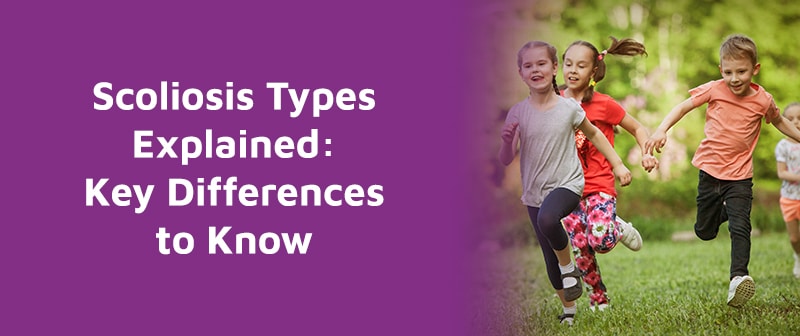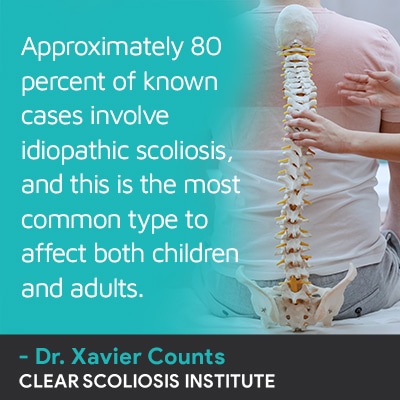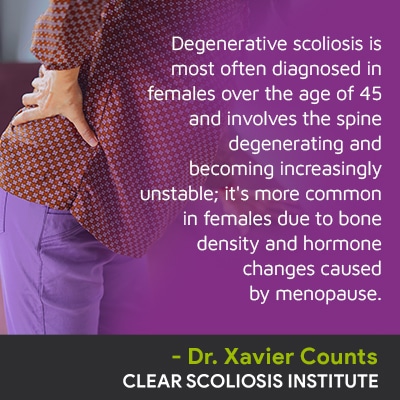
Part of a patient's initial assessment and diagnosis involves further classifying conditions based on a number of key variables, one of which is type. When the underlying cause of scoliosis is known, it's the focus of treatment, and the accuracy of a patient's initial assessment and diagnosis shapes treatment outcome.
There is more than one type of scoliosis, and type is determined by a condition's cause. Most cases of scoliosis are idiopathic, meaning cause unknown, and cases associated with known causes include neuromuscular scoliosis, degenerative scoliosis, and congenital scoliosis.
Understanding the key differences between the different types of scoliosis means awareness of their treatment needs and can help with recognizing the condition's early signs.
Scoliosis causes the spine to develop an unnatural sideways bend and rotation, and an unhealthy spinal curve can disrupt the spine's overall balance and alignment, along with the alignment of the entire body.
Idiopathic means not clearly associated with a single causative source, or simply cause unknown, but we know it's growth that makes scoliosis progress.
Although idiopathic scoliosis isn't associated with a single-known cause, it's been suggested that it could be multifactorial: caused by a number of factors, or a combination of factors, that can range from one person to the next.
Risk factors for scoliosis include gender, age, and a family history. Females are more likely to be diagnosed and experience rapid progression, adolescents approaching puberty are most often diagnosed, and having a family history increases the likelihood of another diagnosis.
The more scoliosis progresses, the more challenging it can be to improve and/or reverse its effects.
As scoliosis progresses, the size and rotation of the unnatural spinal curve is increasing, and this can cause scoliosis effects to become more overt, and this is usually when scoliosis is diagnosed: after enough progression has occurred to make the symptoms noticeable enough to lead to an assessment.

Scoliosis affects all ages but is most commonly diagnosed during adolescence as adolescent idiopathic scoliosis (AIS), and as a progressive condition, the nature of scoliosis is to change and become more severe.
Adolescents are the most at risk for rapid advancement due to the unpredictable and rapid growth spurts of puberty.
AIS is most commonly diagnosed around 11 years of age in females, and a little later in males, and females are also more likely to experience rapid curve progression.
So even scoliosis that's diagnosed as mild doesn't mean it will stay that way, at least not without the help of a customized treatment plan.
While a diagnosis of idiopathic scoliosis means we don't know what caused the scoliosis to develop initially, we do know what makes it progress, and we do know how to treat it effectively.
Now that we've explored the most common type of scoliosis, let's discuss less-typical forms that are associated with known causes.
Neuromuscular scoliosis cases tend to be severe and are caused by the presence of a larger neuromuscular condition like spina bifida, cerebral palsy, or muscular dystrophy causing an interruption in communication between the brain and muscles/connective tissues that support the spine.
It's not guaranteed that everyone with a neuromuscular condition will develop scoliosis, but it is a common complication, and the underlying neuromuscular condition has to be the focus of treatment.
Many neuromuscular scoliosis patients become unable to walk on their own, and this is due to the underlying neuromuscular cause.
Degenerative scoliosis affects older adults and is caused by degenerative instability. Although scoliosis is more often diagnosed during adolescence, the rate of scoliosis increases among the aging population.

Most spinal degeneration starts in the discs that sit between adjacent vertebrae, and as degenerative scoliosis involves increasing instability, it's almost always progressive and painful: lower back pain is the main complaint.
A focus of treatment for degenerative scoliosis is fall prevention through improving the spine's balance and stability.
Congenital scoliosis is a rare type and is caused by the spine not forming properly in utero.
Common spinal malformations involve the spine's vertebrae being more triangular in shape, causing the spine to not form in a straight and neutral alignment, or multiple vertebral bodies can become fused together as they are forming, instead becoming one solid bone and disrupting the spine's ability to form healthy curves.
Babies who present with congenital scoliosis need to be comprehensively assessed as additional congenital abnormalities are common.
So as you can see, there are different types of scoliosis, just as there are different types of scoliosis curves and patterns, and this is why customization of treatment plans is so important.
And regardless of types or severity, the best time to start treating a scoliosis is always now; as a progressive condition, the timing of when treatment is started shapes treatment outcome.
All types of scoliosis can benefit from a proactive treatment plan, and while spinal surgery is a treatment option for some scoliosis patients, it is an invasive procedure that many patients don't need.
When it comes to long-term spinal strength and flexibility, spinal fusion surgery isn't always the best option. A fused spine is weaker and more likely to be injured, and many patients are disappointed with the range of motion they are left with.
As a progressive condition, nonsurgical scoliosis treatment is ongoing so it can shape the spine's long-term health and function, but as it prioritizes preserving its natural strength and function, it's better for the spine's long-term health.
Even though we don't know what causes most cases of scoliosis, we know how to respond with treatment, and we know the timing of treatment is important.
Particularly when it comes to childhood scoliosis, being proactive to counteract progression during growth is key, and while there are never treatment guarantees, there are a number of benefits associated with early detection and intervention.
Here at the CLEAR Scoliosis Institute, the approach is patient-centered and integrative, combining the power of multiple scoliosis-specific treatment disciplines to impact scoliosis on every level.
Conservative treatment options work together to impact the spine and its surrounding muscles.
A first step to addressing a scoliosis is determining its type and underlying cause, and patient age, condition severity, and location within the spine are additional key factors treatment plans are shaped around.
Through scoliosis-specific chiropractic care, the spine's position may be improved on a structural level, and the spine's position-change needs to be supported, so physical therapy focuses on strengthening the spine's surrounding muscles for more support and stability.
Scoliosis-specific physical therapy and exercises also work towards improving the spine's surrounding muscle balance, posture, and restoring healthy movement patterns.
Corrective bracing can be particularly helpful when addressing childhood scoliosis by improving the spine's position while allowing for movement; this makes it complement a scoliosis-specific exercise program.
Rehabilitation can involve the prescription of home exercises and continued chiropractic care, and can help sustain treatment results for the long term.
What's most important to understand about scoliosis is that despite its cause, it needs to be treated proactively, and as a progressive condition, a diagnosis of mild scoliosis doesn't mean there is more time to act, doesn't indicate a lack of urgency, or that observing is enough; when scoliosis is mild is the best time to start treatment.
And patients whose scoliosis was diagnosed while mild have an opportunity: the chance to start treatment while the curve is still minor and is most likely to respond well to nonsurgical treatment.
Scoliosis plans need to be customized. Not only does scoliosis range widely in severity from mild to severe scoliosis, there are also different curve types and condition types.
The most common type of scoliosis is idiopathic scoliosis with no known cause, and the remaining types associated with known causes include neuromuscular scoliosis, degenerative scoliosis, and congenital scoliosis.
Whether the cause of scoliosis is unknown, involves the presence of a larger neuromuscular condition, natural age-related spinal degeneration, or a malformed spine, treatment is key, and the sooner it's started, the better.
As a CLEAR-certified scoliosis chiropractor, the goal is to restore balance and stability to the spine by reducing the size of the unnatural spinal curve and improving the balance and support of the spine's surrounding muscles.

CLEAR provides a unique and innovative way of understanding scoliosis. Sign up to receive facts and information you won’t find anywhere else.
